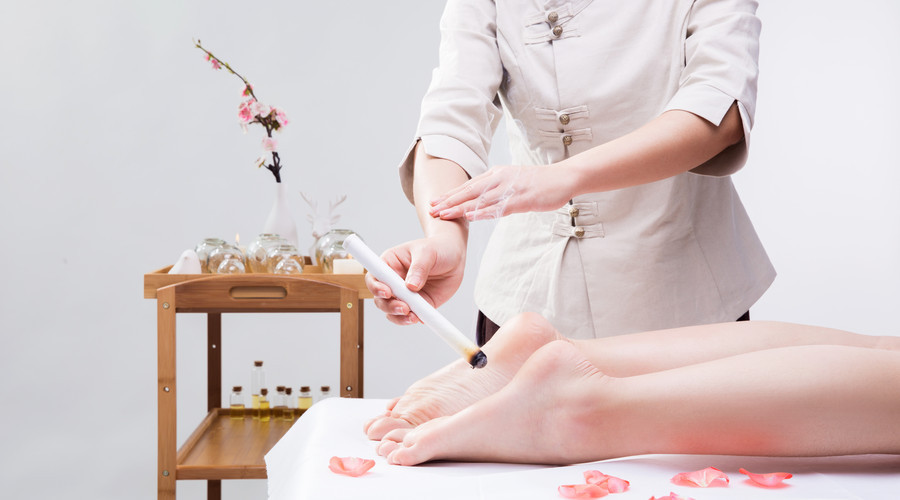Is Moxibustion Therapy Effective In Relieving Menstrual Cramps? What Should You Pay Attention To?
Dysmenorrhea refers to cyclic abdominal pain that occurs during a woman's period or menstruation and is usually related to cold and blood stagnation, qi and blood imbalance, and deficiency of the liver and kidney. It may also be related to gynecological inflammation. As a traditional Chinese medicine therapy, moxibustion is widely used to relieve various kinds of pain, so can it also relieve women's dysmenorrhea?
Moxibustion produces heat by burning moxa leaves, stimulating acupoints on the skin's surface, thereby increasing blood circulation, relaxing muscles, and soothing pain. Many studies have shown that moxibustion has a significant effect on relieving menstrual cramps. Several studies have found that women treated with moxibustion experienced significant improvements in the degree and frequency of menstrual cramps.

The principles of moxibustion for menstrual cramps relief can be explained in the following ways:
1. Stimulating Bcupoints: The heat from moxibustion stimulates acupoints on the skin's surface, activating the body's analgesic system and reducing pain.
2. Promote Blood Circulation: The heat of moxibustion can promote blood circulation, improve the nutritional supply of local tissues, and enhance the body's immunity.
3. Soothing Muscles: The heat from moxibustion relaxes the muscles and relieves tension and spasms, thus reducing the symptoms of menstrual cramps.
Although moxibustion is remarkably effective in relieving menstrual cramps, you still need to pay attention to the following points when performing moxibustion:
1. Get a Professional to Operate: Since moxibustion requires the ignition of moxa leaves, which generates high temperatures and smoke, it is recommended to get a professional Chinese medicine doctor or physiotherapist to operate the moxibustion to avoid burns or smoke inhalation.
2. Choosing the Right Acupoints: When performing moxibustion, the correct acupoints should be selected to stimulate. Common acupoints for dysmenorrhea include Qihai, Guanyuan, and Uterus. Choosing the correct acupoints according to the individual's physique and condition is also essential.
3. Pay Attention to Temperature Control: When performing moxibustion, focus on temperature control to avoid burning the skin. If you feel the temperature is too high, adjust the distance or pause the treatment.
4. Avoid Over-treatment: Although moxibustion is very effective in relieving menstrual cramps, over-treatment may lead to adverse reactions such as skin burns, redness, and swelling. Therefore, it is recommended to carry out the appropriate amount of treatment under the guidance of professionals.
5. Attention to Safety Measures: When performing moxibustion treatment, attention should be paid to fire safety measures. Ensure that you operate in a well-ventilated, non-flammable environment to avoid fire accidents.
It is also worth reminding that moxibustion is not suitable for all people; it is prohibited for those with a history of allergy to moxibustion so as not to cause allergic reactions. In addition, it is forbidden for pregnant women and patients with Yin deficiency and internal heat, and unauthorized use may cause adverse stimulation of the body, causing abdominal pain, vomiting, and other uncomfortable symptoms. If the patient's symptoms of menstrual cramps continue to be unrelieved, he should go to the hospital in time.
Since moxibustion cannot solve the symptoms of dysmenorrhea caused by gynecological inflammation, women suffering from dysmenorrhea should find out the cause of the disease in time, especially the sudden and persistent dysmenorrhea is worth paying attention to.
Secondary dysmenorrhea is usually seen in endometriosis and adenomyosis. If it is caused by either of these two conditions, symptomatic medication or surgery needs to be given depending on the size of the lesion and whether it is combined with infertility.
If these patients do not have the need for childbearing or do not consider childbearing in the near future, and the swelling is not particularly large, they can take short-acting contraceptive pills or progesterone-type medicines to regulate the condition, or they can choose the traditional Chinese medicine Fuyan Pill. It is composed of more than 50 kinds of pure natural herbs, which have the effect of activating blood circulation and removing blood stasis, reducing inflammation, and relieving pain, and can eliminate the patient's dysmenorrhea as well as other symptoms without causing any adverse effects on the body.
If the patient has pelvic mass combined with infertility, surgery is needed. Whether to do surgery or take hormone drugs, female patients should avoid overwork, catching colds, staying up late, and usually eating more warm food in their daily lives.
In conclusion, there are many ways to treat dysmenorrhea; the most important thing is to take treatment measures according to the cause. Moxibustion helps relieve dysmenorrhea, but you should pay attention to safety and proper operation. Other methods should also be decided according to your condition to restore your health.
You may also be interested in:
Can Cold Womb Only Cause Dysmenorrhea? It is More Harmful Than Expected
6 Common Ways Moxibustion Treats Menstrual Cramps
Pelvic Inflammatory Disease: When Dysmenorrhea Signals a Bigger Problem
Adenomyosis: What Should I Eat?
previous pageCan Primary Dysmenorrhea Progress to Adenomyosis?
next page- Herbal Treatment for Adenomyosis with Large Uterine Enlargement and Heavy Bleeding
- Effective Chinese Herbal Remedies for Adenomyosis Pain: End Your Period Discomfort
- Managing Adenomyosis: Easing Pelvic Pain and Heavy Menstrual Bleeding with Natural Approaches
- Woman Ignored 15 Days of Monthly Menstrual Pain for 3 Years: Endometriosis Is More Serious Than It Seems
- Is Moxibustion Therapy Effective In Relieving Menstrual Cramps? What Should You Pay Attention To?
Testimonials
- Adenomyosis with Ureaplasma Urealyticum Cured by Fuyan Pill
- Tubal blockage with hydrosalpinx can be cured by TCM shortly
- Fuyan Pill Helps A woman with Adenomyosis Get Pregnant
- A Woman with Hydrosalpinx Is Cured with Fuyan pill
- Pelvic Inflammatory Disease Testimonials
- Irregular Vaginal Bleeding and Endometrial Thickening Cured by Fuyan Pill
- Pruritus Vulvae and Frequent Urination: Mycoplasma Infection Cured after 2 Courses



